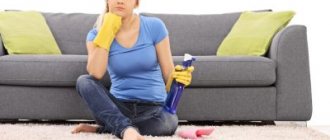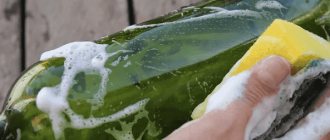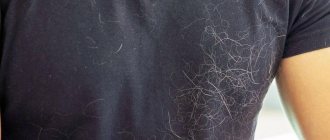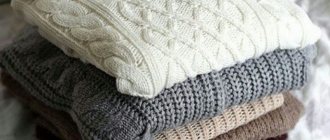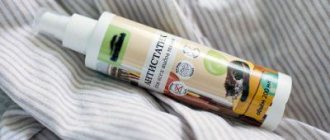Most often, pet owners face the problem of sticky fur.
To get rid of hairs on clothes, upholstered furniture and carpet, special and improvised devices are successfully used.
We will tell you in this article how to remove hair from cats, dogs and other animals in an apartment or house, from blankets, bed linen, and from the washing machine.
Start with yourself
If you wean your beloved pets from jumping on upholstered furniture, then the problem of the sofa becoming covered in cat or dog hair will immediately disappear. But under no circumstances should you hit animals. Both cats and dogs will eventually stop encroaching on the sofa if you simply remove them from there and put them on the floor without any emotional outbursts. Here you need to show patience and pedantry. If at least sometimes the owners give in, the tailed animals will never understand what these unpredictable two-legged members of their native pack want to achieve from them. Therefore, the educational process should begin with yourself.
Regular rubber glove
A rubber glove is one of the best means for cleaning a sofa from animal hair. Don't believe me? And this is so.
It is enough to lightly moisten the glove with water (you can do it dry, but wet is more effective) and start cleaning the sofa. Wool sticks to rubber very quickly, so the glove will need to be rinsed periodically. Important! – you need to clean the surface in one direction so that the wool does not get tangled in the pile.
Application of sticky roller
A faster way is to use a sticky roller to clean clothes. The downside is that the roller gets clogged very quickly. If the stains are severe, one replacement roll may not even be enough. But if you need to get rid of the problem urgently, for example, before guests arrive, then laying a new bedspread will be a more efficient way. Cleaning should begin from the top parts of the upholstery, gradually moving down.
If there is no roller, tape is also used. To speed up the process, adhesive tape can be wrapped around the bottle with the sticky side facing out.
Special devices
Special devices that are easy to purchase help you clean pet hair efficiently.
They have many advantages:
- ease of use;
- do not damage the material;
- for the most part, they are not very expensive.
Sticky roller
A sticky roller is a convenient hand tool. This is a roller with a cylindrical working attachment; it allows you to quickly process clothes.
Holding the roller by the handle, treat areas of the fabric that have fibers. In this case, not only wool, but also dust, scraps of thread, etc. collect on the sticky surface.
Once the adhesive roller has run out, you can purchase a replacement unit.
Brush
The wool brush visually resembles a massage comb. The hairy teeth on its working surface are very short. Holding the tool by the handle, make smooth movements with the brush, moving it across the fabric from top to bottom. At the same time, the animal's hair is reliably grabbed by the teeth.
Sponge
A wool sponge can be made of different materials. It is most convenient to use a reusable rubber one. It is used for its intended purpose in a dry state.
After use, the sponge should be thoroughly rinsed and dried. It is advisable to do this immediately after cleaning things.
Rubber glove
A special rubber glove is well suited for collecting wool. On the palm side there are small rubber “spikes” that allow you to remove all the hairs from things.
The glove is put on the hand and stroked over the fabric . After this, the glove is rinsed and dried.
Turbo brush of a vacuum cleaner
The turbo brush is a roller-shaped attachment. The bristles on it are located diagonally.
Thanks to the intense rotation and specific location of the bristles of the nozzle, this option is very convenient for removing hair from the carpet.
In addition to collecting wool, the turbo brush has a number of additional functions:
- dust removal;
- removing small debris from carpets;
- elimination of complex contaminants.
If the turbo brush is not included in the standard package of the vacuum cleaner, it can be purchased separately.
Scotch
When you don’t have any special tools at hand, you can use tape. Its use is organized according to the principle of a sticky roller: wool from clothing is simply glued to the sticky side of the tape.
There are 2 possible application options:
- A strip of not very long length is cut from a roll of wide tape. Its sticky part is applied to clothing and removed with a jerk. And repeat on a new site.
- Double-sided tape must be glued to a kitchen rolling pin on one of the adhesive sides. And only after that the protective layer is removed from the other side. Roll a rolling pin over the item laid out on a flat surface.
After several uses, the tape becomes unusable and requires replacement.
Wet broom
A simple but reliable way to remove hair from flooring is to use a damp broom. Before sweeping, hold the broom by the handle, dip it into a bucket of water, and squeeze out the excess moisture.
Animal hair, when swept with a broom, collects on it, so it must be removed as the area is treated.
Wash
If the sofa is covered with a cover, then the top cover can be removed and washed. Simply washing will not help get rid of fur. Here you will have to perform a number of actions:
- First, the case should be shaken out well, and if possible, then go over it with a beater.
- You need to put a plastic bag in the washing machine drum along with the cover.
- The wool will begin to stick to the bag due to the resulting static electricity. Opponents of this method say that no static electricity can arise in water, and even in a grounded washing machine. It is quite possible that the process actually occurs according to some other physical laws, but the fact remains a fact. Wool fibers are attracted specifically to the bag.
True, practical experimenters do not recommend washing woolen fabrics in this way. It is difficult to say what exactly this is connected with. All you have to do is take their word for it.
Are you ready to conduct a practical experiment on washing a sofa cover along with a plastic bag?
How to prevent hair from appearing on upholstered furniture
Pre-treating the surface of the sofa greatly reduces the amount of accumulated wool and makes it easier to collect. The essence of these methods is to reduce static electricity.
| Way | Description |
| Antistatic | These spray cans are sold in supermarkets and hardware stores. They come with a pleasant aroma and no smell at all. Universal antistatic agents are suitable for the sofa (sometimes it is written “for all types of fabric”). The drug is inexpensive, and one spray is enough for several days. Good brands are Chirton, Lira, Bagi, Diamonds, Big D, Lana. |
| Table vinegar | An excellent home replacement for antistatic agent. You can apply it with a cotton pad, but it’s better to put it in a spray bottle and use it as a spray. Due to the pungent odor, it is worth opening the window before processing. |
| Salt and lemon | The sofa is sprayed with plain water, adding a pinch of salt to it. Sometimes salt is replaced with lemon juice - 1 tsp. A bottle of water will be enough. |
Separately, there are 2 more useful preventive measures:
- If your pet has a favorite place on the sofa, you can place a comfortable bed there. She will collect the wool, not the sofa. And the beds are sewn in such a way that shaking them out is much easier than cleaning the upholstery of upholstered furniture.
- During the molting period, it is recommended to brush your pet’s fur daily using a slicker brush or a special comb. Bathing with shampoo purchased at a pet store also helps. With regular care, there will be significantly less hair on the sofa.
LiveInternetLiveInternet
Quote from Mamin_dnevnik message
Read in full In your quotation book or community!
How I clean cat hair from carpets and upholstery
I have two cats living in my house, and where there are cats, there is fur. Especially in a house like ours, where there are carpets and rugs almost everywhere. Although, good housewives, and simply successful women, solve this minor household issue without any problems. I'll tell you how I solve this issue.
The photo is quite old. Here we just moved into this house (less than a week passed after moving), so there were no traces of any carpets
The most problematic carpet I have is the carpet in the living room. And, by the way, cats are not the only ones to blame for this. They are also helped by children who are not averse to crunching on crackers or cookies in this living room. Therefore, no, no, and you have to hear from friends... “You should clean the carpet, otherwise it doesn’t look very good compared to the rest of the house.”
To be honest, I clean it regularly. And this post, in principle, is what I want to dedicate to the topic of cleaning carpets and upholstered furniture in the presence of cats.
Let me start with the fact that carpets are different. There are those that I call “problematic”, and there are those that are “problematic”. The “problem carpet” is the carpet in our living room. This is a carpet with a long pile to which everything sticks very quickly, it’s not so easy to clean... What am I doing? Firstly, I vacuum the carpet once every 2 days. To be honest, I tried to vacuum it every day, but it can just go crazy if you clean it like that. Therefore, I found the best option for myself - to clean the carpet once every 2 days. More often than not, I just don’t see the point.
But the carpet isn't the only place cats like to leave their fur. There is another very favorite place - upholstered furniture. Many housewives know how difficult it can sometimes be to assemble it. And so, along with cleaning the carpet in the living room, I also clean the furniture. But I don’t clean all the furniture, but only those places where cats like to pamper themselves and lie down. For me, this is usually the back of a sofa or chair. These are the places I go through with a special brush.
I won’t explain what this brush looks like, since it’s easier to see once than to hear (in this case, read) 100 times. So, I have something like this:
In fact, this is not a brush for cleaning furniture, but a brush for clothes, but it does an excellent job of cleaning furniture. I wrote that it is approximately, since mine is not double-sided, but one-sided. To be honest, I have tried many products for cleaning furniture from cat hair, but this particular brush has become my lifesaver. I also tried adhesive tapes for cleaning furniture from cat hair, but I was not impressed, because once I applied it, I could throw it away. And my pets shed a lot of hair... And this brush, like in the picture, is reusable.
I think you understand the principle of operation of the brush - sweep it over the surface to be cleaned, the wool clings to the fibers and comes off the furniture. It can also be removed from the brush itself once or twice – you can even just use your hand. And one more thing I would like to point out. The big plus is that the brush has a long handle - this allows you to get into the most difficult to reach places.
It’s not for nothing that I spent so long on the living room, since for me this is one of the problem areas, as I wrote above. Well, you understand - the whole family gathers here, plays board games, and the cats are right there... also members of the family, so to speak.
The living room carpet isn't the only place where you have to deal with cat hair. Another place is children's rooms. True, here, as I wrote above, the carpet is not at all problematic - so it’s enough to go over it with a vacuum cleaner once a week and everything is clean. I know that carpets also come with different piles and different types. Therefore, I now surfed the Internet (what would I do without it) and found out that in our boys’ room we have a fabric-based carpet. By the way, the picture is something like this:
And I still have a carpet in the girls’ room. I must say that although the fur is visible there, it’s not very noticeable. To be honest, my girls don’t care much about this. If it were up to them, they would go through the vacuum cleaner once a week and enjoy life. But my husband is a neat guy, and I myself can’t bear to look at it, so a couple of times a week we clean this carpet of cat hair. What are we doing? Everything is very simple - take a regular household brush with stiff plastic bristles.
and a bucket of water with which we dilute a little detergent. Any detergent will do, but I prefer to use Faberlic All-Purpose Cleaner. So, add the detergent to the water, lather it well, and you can start cleaning the carpet. And yes, our husband most often does this work, since he does it much faster than me. If it takes him 15 - 20 minutes, then I can easily spend an hour with this task. You understand that a man has more strength and a different scope. In general, I am very glad that there is someone who voluntarily agrees to help me in the fight against cat hair.
Let's summarize. Yes, keeping cats with long hair at home is very problematic, some difficulties arise, but at the same time, I love my beauties so much that I am ready to forgive them for this fur lying around everywhere. As a matter of fact, carpets and upholstered furniture are the only problem areas when keeping cats in the house. Everything else is nonsense. For example, it is easy to sweep up all the fur from the floor. As a last resort, wipe the floors with a damp cloth and you're good to go. Carpets are a little more complicated, but even here everything is easily solved - most often I clean upholstered furniture and the carpet in the living room, then the carpet in the girls’ room, and least often in the boys’ room.
I tried to describe it in as much detail as possible, but if you still have any questions, be sure to ask them - I will answer any, as feedback is always interesting.
Why does a dog shed?
The dog's body is no different from other mammals: natural organic processes constantly occur inside it, one of which is the renewal of hair and skin. If daily hair loss from 50 to 150 hairs is considered normal for a person with more modest (compared to a dog) hairiness, then what intensity should the animal’s fur renewal have?
Coat change occurs especially intensively twice a year: in spring and autumn. In warm weather, the animal’s fur coat adapts to the heat, getting rid of the undercoat; in cold weather, on the contrary, it acquires a denser undercoat, preparing to survive the winter cold. In young animals, the molting period passes quite quickly; in older animals it can be delayed. Prolonged molting may indicate the occurrence of a disease, parasites or a lack of essential vitamins due to improperly organized nutrition. You should immediately contact your veterinarian with this problem.
In females, shedding occurs intensively even after she has stopped feeding the puppies. The reason for this process is a change in the dog’s hormonal levels.
It is a mistake to believe that there are breeds that are not subject to shedding. All individuals that grow hair on their bodies shed them many times during their lives. It’s just that for some they fall out without any problems, while for others the fur needs to be carefully combed to avoid the formation of tangles.
Breeders note that dogs that spend most of their time outside change their coat more intensively, while domestic dogs can shed all year round in a sluggish manner. And this becomes a real headache: where to get away from the ubiquitous fur and is it even possible to escape from it without parting with your beloved animal?



